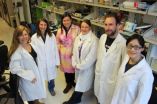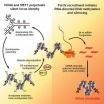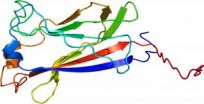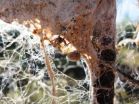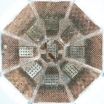(Press-News.org) Proteins that regulate energy metabolism are essential for stem cell formation, University of Washington researchers find.
Two proteins that control how cells metabolize glucose play a key role in the formation of human stem cells, UW researchers report.
The findings advance scientists' understanding of stem cell development but also suggest that the proteins, which also play a role in the process that transforms normal cells into cancer stem cells, might also be targets for new cancer therapies, the researchers write.
The findings appear online in the journal Cell Stem Cell. The paper's lead authors are Julie Mathieu, a post-doctoral fellow at the UW and Wenyu Zhou who was a graduate student at UW and is now a postdoctoral scholar at Stanford University, Department of Genetics. Dr. Hannele Ruohola-Baker, UW professor of biochemistry, is the paper's senior author.
In the study, the researchers induced mature human tissue fibroblasts to revert to an earlier stem cell-like state by inserting genes for four proteins, a process called reprogramming.
These reprogrammed cells have the extraordinary ability to develop into any type of cell in the human body, a capacity called pluripotency, and it is hoped that induced-pluripotent stem cells will one day be able to be used to create new tissues and organs to repair and replace those damaged by injury and disease.
Researches have known for some time that during reprogramming, cells must go through a stage in which they shut down metabolic pathway that they use to generate energy from glucose that requires the presence of oxygen in mitochondria, the cell's powerhouse and shift over to another pathway, called the glycolytic pathway, that generates less energy but does not require the presence of oxygen.
This shift may take place because in nature, embryonic and tissue stem cells often must survive in low-oxygen, or hypoxic, conditions.
This transition to a glycolytic state is of particular interest to cancer researchers as well, since as normal cells are transformed into cancer cells, which in many ways resemble stem cells, they, too, go through a glycolytic phase.
In their study, the UW researchers focused on the function of two proteins: hypoxia-induced factor 1α and 2α, or HIF1α and HIF2α. These proteins are transcription factors which mean they affect the regulation of a number of genes, allowing them to dramatically alter a cell's behavior. The researchers showed through loss-of-function analysis that each protein, HIF1α as well as HIF2α is required for generation of stem cells through reprogramming.
To tease out the impact of HIF1α and 2α on cellular processes in more detail, they stabilized the proteins in an active form and tested what each protein could do alone. They found that when HIF1α was stabilized, the cells went into the glycolytic state and produced more induced pluripotent stem cells than normal.
However, when they just activated HIF2α, they found the cells failed to develop into stem cells. "This was a big surprise," said Mathieu. "These proteins are very similar but HIF1α gives you lots of stem cells; HIF2α, none."
If stabilized together, HIF2α won the battle, repressing all stem cell formation.
Further investigation found that HIF2α does indeed promote the shift to glycolysis in an early stage of the cells' reprogramming but if it persists too long has the opposite effect, blocking the progression to the stem cell state.
"HIF2α is like Darth Vader, originally a Jedi who falls to the dark side," said Ruohola-Baker. "While HIF1α, the good guy is beneficial for reprogramming throughout the process, HIF2α, if not eliminated, turns bad in the middle and represses pluripotency."
HIF2α does this in part by upregulating the production of another protein, called TRAIL, for TNF-related apoptosis-inducing ligand, that is known to, among other things, cause tumor cells to self-destruct through a process called apoptosis.
Zhou said the findings suggest that there may be other proteins in this protein family that are playing alternating "good guy/bad guy" roles during stem cell development. "It is very intriguing that HIF2α has the capacity to both promote and repress pluripotency, doing so at different stages in a cellular reprogramming process," she said.
The findings have several implications for stem cell research, says Mathieu: first, they indicate that it may be possible to use HIF1α to greatly increase the number of stem cells in a culture and, second, they suggest it may be possible to induce stem cell formation with HIF proteins alone or in combination with other stimulating factors without inserting genes at the start of the reprogramming process.
But the findings may also have important implications for cancer research Ruohola-Baker added: Both HIF1α and 2α are known to play an important role in the process in which normal cells are transformed into cancer stem cells from which tumors grow, indeed, the presence of activated HIF1α is known to be a marker for aggressive disease.
The finding of this study suggest, Ruohola-Baker said, that it might be possible to interfere with cancer development by either blocking the effect of HIF1α in malignant cells early in the process or stimulating the effect of HIF2 at a later stage.
INFORMATION:
Mathieu, Zhou and Ruohola-Baker's collaborators were Yalan Xing, Henrik Sperber, Amy Ferreccio, Zsuzsa Agoston, Kavitha T. Kuppusamy, and Randall T. Moon, who all work at the UW Institute for Stem Cell and Regenerative Medicine.
The work was supported by fellowships by fellowships from the American Heart Association, a Tietze Award, and grants from the National Institutes of Health: R01GM097372, R01GM083867, R01GM083867-02S2, U01HL100395 and P01GM081619
Reference: Mathieu et al. Hypoxia-Inducible Factors Have Distinct and Stage-Specific Roles during Reprogramming of Human Cells to Pluripotency. Cell Stem Cell (2014), http://dx.doi.org/10.1016/j.stem.2014.02.012.
About UW Medicine
UW Medicineʼs mission is to improve the health of the public by advancing medical knowledge, providing patient care, and training the next generation of health professionals. Our system includes Harborview Medical Center, Northwest Hospital & Medical Center, Valley Medical Center, UW Medical Center, UW Neighborhood Clinics, UW Physicians, UW School of Medicine and Airlift Northwest. Visit http://uwmedicine.org for details. Twitter: @UWM
Proteins that control energy use necessary to form stem cells
Findings advance efforts to reprogram mature cells for organ repair
2014-03-20
ELSE PRESS RELEASES FROM THIS DATE:
Gene silencing instructions acquired through 'molecular memory' tags on chromatin
2014-03-20
BLOOMINGTON, Ind. -- Scientists at Indiana University have unlocked one of the mysteries of modern genetics: how acquired traits can be passed between generations in a process called epigenetic inheritance. The new work finds that cells don't know to silence some genes based on information hardwired into their DNA sequences, but recognize heritable chemical marks that are added to the genes. These chemical tags serve as a form of molecular memory, allowing cells to recognize the genes and remember to silence them again in each new generation.
The discovery made by a 12-member ...
Study reveals a major mechanism driving kidney cancer progression
2014-03-20
The shortage of oxygen, or hypoxia, created when rapidly multiplying kidney cancer cells outgrow their local blood supply can accelerate tumor growth by causing a nuclear protein called SPOP—which normally suppresses tumor growth—to move out of the nucleus to the cytoplasm, where it has the opposite effect, promoting rapid proliferation.
In the March 20, 2014, issue of the journal Cancer Cell, researchers from Chicago and Beijing describe the mechanisms that enable hypoxia to cause the overexpression of SPOP. They show that hypoxia also stimulates the shuttling of SPOP ...
Passive acoustic monitoring reveals clues to minke whale calling behavior and movements
2014-03-20
Scientists using passive acoustic monitoring to track minke whales in the Northwest Atlantic have found clues in the individual calling behaviors and movements of this species. These findings, recently published online in the journal Behaviour, provide insight into one of the least studied baleen whales.
"Although we regularly observe minke whales in our Gulf of Maine surveys, we know very little about minke whale vocalizations and how they use sound in their behavioral and social interactions," said Denise Risch, lead author of the study and a marine mammal researcher ...
Size, personality matter in how Kalahari social spiders perform tasks
2014-03-20
At first glance, colonies of thousands of social spiders all look the same and are busy with the same tasks. Not so, says researchers Carl Keiser and Devin Jones of the University of Pittsburgh in the US, after carefully studying various gatherings of Stegodyphus dumicola social spiders of the Kalahari Desert in South Africa. The size and condition of a particular spider's body indicates which task it generally performs within a colony. In addition, neighboring colonies can have different "personalities" too, writes Keiser, lead author of a study published in Springer's ...
Swing voters hold more sway over candidates on economic issues
2014-03-20
CHAMPAIGN, Ill. — New research from two University of Illinois economics professors who study election trends analyzes how polarization on social issues affects competing candidates' economic platforms.
In the paper, co-authors Stefan Krasa and Mattias Polborn develop a theory of candidate competition that accounts for the influence of both economic and cultural issues on individual voting behavior.
"Many pundits and academics have argued that political polarization, particularly on social and cultural issues, has increased in the U.S.," said Polborn, also a professor ...
UTMB researchers discover a way to potentially slow down Alzheimer's
2014-03-20
Researchers at the University of Texas Medical Branch at Galveston have discovered a way to potentially halt the progression of dementia caused by accumulation of a protein known as tau.
Normally, tau protein is involved in microtubule formation, which acts as a brain cell's transportation system for carrying nutrients in and waste out. In the absence of tau protein, brain cells become dysfunctional and eventually die.
In many forms of dementia, such as Alzheimer's disease and chronic traumatic encephalopathy caused by multiple concussions, the tau protein starts behaving ...
What singing fruit flies can tell us about quick decisions
2014-03-20
You wouldn't hear the mating song of the male fruit fly as you reached for the infested bananas in your kitchen. Yet, the neural activity behind the insect's amorous call could help scientists understand how you made the quick decision to pull your hand back from the tiny swarm.
Male fruit flies base the pitch and tempo of their mating song on the movement and behavior of their desired female, Princeton University researchers have discovered. In the animal kingdom, lusty warblers such as birds typically have a mating song with a stereotyped pattern. A fruit fly's song, ...
As age-friendly technologies emerge, experts recommend policy changes
2014-03-20
From smart phones to smart cars, both public and private entities must consider the needs of older adults in order to help them optimize the use of new technologies, according to the latest issue of Public Policy & Aging Report (PP&AR), titled "Aging and Technology: The Promise and the Paradox." A total of eight articles all from authors affiliated with the Massachusetts Institute of Technology AgeLab are featured.
"Remarkable technological advances are all around us, and leaders in the business and scientific communities are keenly aware of 'the aging of America' and ...
A braking system for immune responses
2014-03-20
The surface of immune system cells is home to a number of receptors which are able to detect pathogens. As soon as these receptors are activated, inflammation occurs and the body's defense mechanisms kick in. Immune cells also have receptors that regulate or even suppress immunological responses to prevent damage to individual cells.
There are other immune receptors that recognize endogenous substances that are released when tissue damage or cell death occurs. As such, the organism can defend itself even in cases where the damage caused by the pathogen, but not the pathogen ...
(Not too) few but capable
2014-03-20
Until the '50s, bluefin tuna fishing was a thriving industry in Norway, second only to sardine fishing. Every year, bluefin tuna used to migrate from the eastern Mediterranean up to the Norwegian coasts. Suddenly, however, over no more than 4-5 years, the tuna never went back to Norway. In an attempt to solve this problem, Giancarlo De Luca from SISSA (the International School for Advanced Studies of Trieste) together with an international team of researchers (from the Centre for Theoretical Physics - ICTP – of Trieste and the Technical University of Denmark) started to ...
LAST 30 PRESS RELEASES:
Tracing the quick synthesis of an industrially important catalyst
New software sheds light on cancer’s hidden genetic networks
UT Health San Antonio awarded $3 million in CPRIT grants to bolster cancer research and prevention efforts in South Texas
Third symposium spotlights global challenge of new contaminants in China’s fight against pollution
From straw to soil harmony: International team reveals how biochar supercharges carbon-smart farming
Myeloma: How AI is redrawing the map of cancer care
Manhattan E. Charurat, Ph.D., MHS invested as the Homer and Martha Gudelsky Distinguished Professor in Medicine at the University of Maryland School of Medicine
Insilico Medicine’s Pharma.AI Q4 Winter Launch Recap: Revolutionizing drug discovery with cutting-edge AI innovations, accelerating the path to pharmaceutical superintelligence
Nanoplastics have diet-dependent impacts on digestive system health
Brain neuron death occurs throughout life and increases with age, a natural human protein drug may halt neuron death in Alzheimer’s disease
SPIE and CLP announce the recipients of the 2025 Advanced Photonics Young Innovator Award
Lessons from the Caldor Fire’s Christmas Valley ‘Miracle’
Ant societies rose by trading individual protection for collective power
Research reveals how ancient viral DNA shapes early embryonic development
A molecular gatekeeper that controls protein synthesis
New ‘cloaking device’ concept to shield sensitive tech from magnetic fields
Researchers show impact of mountain building and climate change on alpine biodiversity
Study models the transition from Neanderthals to modern humans in Europe
University of Phoenix College of Doctoral Studies releases white paper on AI-driven skilling to reduce burnout and restore worker autonomy
AIs fail at the game of visual “telephone”
The levers for a sustainable food system
Potential changes in US homelessness by ending federal support for housing first programs
Vulnerability of large language models to prompt injection when providing medical advice
Researchers develop new system for high-energy-density, long-life, multi-electron transfer bromine-based flow batteries
Ending federal support for housing first programs could increase U.S. homelessness by 5% in one year, new JAMA study finds
New research uncovers molecular ‘safety switch’ shielding cancers from immune attack
Bacteria resisting viral infection can still sink carbon to ocean floor
Younger biological age may increase depression risk in older women during COVID-19
Bharat Innovates 2026 National Basecamp Showcases India’s Most Promising Deep-Tech Ventures
Here’s what determines whether your income level rises or falls
[Press-News.org] Proteins that control energy use necessary to form stem cellsFindings advance efforts to reprogram mature cells for organ repair
